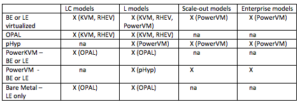Ron Gordon
Director – Power Systems
I have received several questions on the various Linux implementation options for Power Systems. The implementation options basically involve installation of a bare metal system, a PowerKVM virtualized system, and PowerVM virtualized system.
– Power Systems Model and Hypervisors:
Let me begin with a little information on the uniqueness of the various Power Systems servers. The LC models only come with OPAL (Open Power Abstraction Layer) which is a light-weight hardware interface for operating systems and virtualization systems. The L model comes with both OPAL and pHyp… pHyp is the hardware interface used by PowerVM for virtualization, or to do DLPAR implementations without PowerVM. On the L models, you can run either OPAL or pHyp, but not both at the same time. Via the ASMI (advanced system management interface), you can switch back and forth between these hypervisors at a re-boot of the system. On the Scale-out and Enterprise class Power Systems that do not have the L or LC designation, only pHyp is provided.
– OPAL Bare Metal and PowerKVM considerations:
With OPAL, you can run Big or Little Endian distributions (Ubuntu, SLES, Redhat) virtualized on PowerKVM or RHEV. OPAL is not supported by PowerVM, so PowerVM will not run the LC servers. If you wish to run bare metal for maximum performance reasons, you can only run Little Endian versions of SLES, Redhat, or Ubuntu (Ubuntu is only Little Endian, so no problem). Since OPAL is only available on the LC and L models, this means that you cannot run bare metal nor PowerKVM on the Scale-out or Enterprise systems.
One might wish to run bare metal in a minimally virtualized environment using DPLARs, but DPLARs are implemented only in pHyp, so this cannot be accomplished on the LC models. On the other hand, it could be accomplished on the L models or the standard Scale-out models, in conjunction with AIX and IBM i. To me, it seems illogical to run DLPAR Linux partitions on the Enterprise class systems.
PowerKVM can be implemented on either the L or LC models, but not on the Scale-out nor Enterprise models, since they do not have OPAL. PowerKVM comes with its own Linux kernel, and can virtualize both BE and LE guests.
– pHyp and PowerVM Considerations:
PowerVM will require pHyp, so it cannot be implemented on the LC models. For virtual partitions on the L models, Scale-out or Enterprise systems, LE or BE distributions can be the guest, and if optimal performance is required, then Dedicated Partitions should be implemented via pHyp, without the need for PowerVM.
– Choosing the optimal runtime environment:
The process for determining what options for Linux servers should be made are based on the application needs. However, sometimes you already have the “server” and then are limited by what options exist. For example, if you have Scale-out or Enterprise POWER8 systems, you can only virtualize with PowerVM. If you have L models you can virtualize both LE and BE distributions with PowerVM. DPLARs, PowerKVM, RHEV, or bare metal depends on which hypervisor you are running. If you have LC models, you can run LE only distributions on bare metal, or if you are virtualizing with PowerKVM, then you can run BE or LE distributions.
If you are trying to determine which server best matches your application need, you should start with the application… BE or LE? Then, do you need optimum performance? And then, would you like a virtualized environment? That should lead you to the correct server selection.
One final thought is that Little Endian distribution can only run on POWER8 systems.
Summary table for POWER8 Systems:
If you would like additional information, please contact Mainline at www.mainline.com or 850-219-5000. You can also contact me at ron.gordon@mainline.com.

